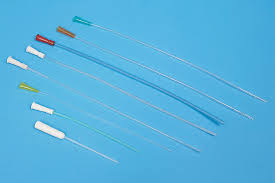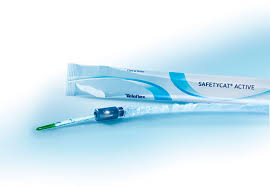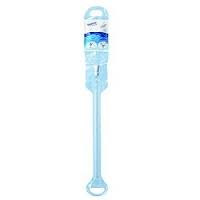Catheters for Intermittant Self-Catheterisation
I have used catheters for intermittant self cathetetisation since 2006 and used Coloplast for many years.

catheters for internittant self catheterisation
Coloplast catheters
I started by using the Coloplast 14 inch catheter; this was fine for use in the house but potentially embarrassing when out and about. At work, for example, how do you carry something into a loo that is bright green, 14″ long and not very foldable and be discrete? In spring 2012 a nurse introduced me to the Coloplast compact catheter. Fantastic, I now had a catheter that I could keep in my pocket and not be embarrassed.
Used Coloplast for 6 years
My relationship with Coloplast catheters did occasionally get a bit strained. I could not always get the catheter into my bladder. Someone suggested removing it, have a cough as if clearing my throat and try again. Occasionally I had to repeat the exercise more than once and sometimes a bit of force was required to get the catheter into the bladder. This process seemed to work and I never gave any thought to an underlying cause.
Discovered other types
I had never been made aware of any other type of catheter until the MS Life 2014 exhibition. At the exhibition there was a stand for Teleflex catheters. The salesman sent me some free samples to try. Then by searching through back copies of various magazines I discovered Manfred Sauer and Lofric catheters. I rang up and asked for some samples.
A slider or catheter sleeve, this allows the catheter to be held without touching it by hand and helps to insert the catheter into the urethra. Each catheter has adantages and disadvatages. Ulyimatey it is personal preference. I now use Manfred Sauer.

Coloplast catheters in intermittent self-catheterisation
Coloplast
Standard 14″ catheter I have used Coloplast catheters since 2008. Its easy to remove from the packaging and the saline is in the packaging but there is no slider.
Compact catheter It is only 7.5 ” long. When you break the seal and pull it out of the base it automatically extends, once again there is no slider. It is very convenient.

Teleflex catheters for intermittent self-catheterisation
Teleflex
Liquick Base. Open it then squeeze a sachet to release the saline solution. There is a blue slider and the catheter very easy to use. The unopened catheter can be folded and put into a pocket so it is easy and discrete to carry around.
Safetycat Active. Open the packet, remnove catheter and protective sleeve. As the catheter is already inserted into a sleeve, simply pull it back as it is inserted into the urethra. Once you have got the knack it is very easy to use.
Both of these catheters pass along the urethra and into the bladder very easily
Manfred Sauer

Manfred Sauer catheters for intermittent self-catheterisation
IQCAth Gel+ No sachet to squeeze, hold catheter at one end and squeeze along length to distribute the gel. Easy to open, tear off some of the packaging for the sleeve and very easy to insert catheter into bladder.

Lofric Primo catheters for intermittent self-catheterisation
Lofric
Arigo Easy to squeeze the sachet and release the saline solution but the slider has a habit of falling off the catheter before insertion into the urethra. At least that is a problem I encountered
Primero Relatively easy to squeeze the pack of saline solution but difficult to tear the packaging for the slidng sleeve. The catheter did not slide into the bladder as easily as I would have liked.
As with all things practice makes perfect and I only had half a dozen of each type of catheter to trial so my complaints might seem to be because of a lack of familiarity. I really like the idea of a sleeve to help with the insertion of the catheter into the urethra
What will I choose
I am very conscious of infection, a UTI is no joke. The absence of a slider on either of the Coloplast catheters is something I take seriously; a wash-hand basin is not always available when out and about. At the moment the jury is still out on what make of catheter I will select. A sample of half a dozen is not quite enough to make a final decision. I do like the Manfred Sauer because it is portable, there is no saline solution to add and it does seem to pass along my urethra and into the bladder very smoothly.
Next step
Make an appointment with my doctor and show him the catheters I would like. The packaging is required so the doctor can select that the correct catheter to put onto my prescription
12 months later
I changed to the Manfred Sauer. They do tend to get a bit gunky when folded up but I do find them very easy to use. Also not suffered a UTI since I changed to them.
Incidentally I’m a bloke. I accept that there is a physiological difference between men and women. A bladder registrar quipped that God was a man and he was experimenting on urethra arrangements with women.
August 2014



I have just started using the Coloplast Standard Catheter, one word sums up my opinion of this product, Freedom. The Foley Catheter has barely changed in 80 years. Patience is the key, no more tubes, bags or straps, this product is a step forward. Sometimes people expect too much, as we progress, these products will improve, with honest feedback, we can help others with similar conditions. This product is good, take advantage of it.
Hello Rob,
The standard catheter to be used by any person is very much a matter of personal choice. I tried the Coloplast and had difficulty getting it into my bladder and now use the IQ. Its a matter of asking for a free sample from each manufacturer and finding the one that suits you. Coloplast has the monopoly in the UK but there are other manufacturers to try